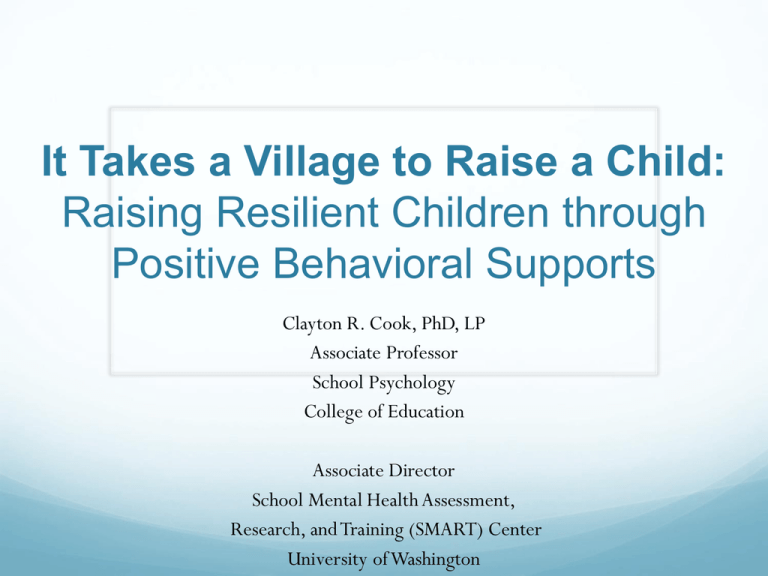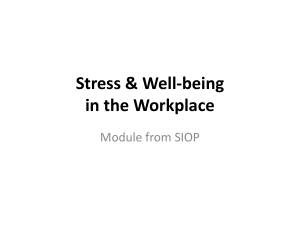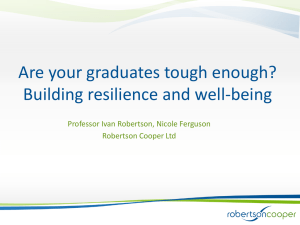Raising Resilient Children
advertisement

It Takes a Village to Raise a Child: Raising Resilient Children through Positive Behavioral Supports Clayton R. Cook, PhD, LP Associate Professor School Psychology College of Education Associate Director School Mental Health Assessment, Research, and Training (SMART) Center University of Washington Big Question? What skills are babies born with? Gerber Baby Two Worlds Students Inhabit • Home • Parent Awareness • School Expectations Monitoring Support Expectations Monitoring Support ParentTeacher Contact Teacher-parent contact Tracking grades, behavior, attendance Behavior, Homework patterns, life stressors • School Awareness What skills enable children to be successful later in life? Resilience Defined Resilience: the ability to survive and thrive in the face of life’s daily ups and downs, curve balls, and stressors. Survival skills (manage stress, bounce back): Bounce back after a challenging, adverse situation Manage and overcome stressors Minimize life suffering Thriving skills (feeling good & getting the most out of life): Flourishing Optimize mental and physical well-being and quality of life Reaching one’s own full potential All Children Can Develop Resilience Resilience does not require something rare or special—it’s ordinary magic. Number of Resilience Factors and Life Satisfaction SOURCE: http://www.michaelfurlong.info/research/covitality.htmlng Ingredients to becoming a resilient person • • • • • • • • • • • • • • • Developing helpful and optimistic thinking Receiving “good” social support Gratitude practices Good sleep Healthy, reasonable, balanced diet Acts of kindness for others Manage intense negative emotions Regular physical activity Mindfulness-based practices Problem-solving conflicts with others Scheduling time for recreation and relaxation Receiving mentoring Identifying inspiring role models Cultivating positive emotions Goal setting and developing a plan to overcome obstacles PRACTICE!!!!! Neurons that fire together wire together (Hebb’s Rule) Formation of habits (automatic thoughts, feelings, behaviors) Child Well-Being Whole-Person Perspective Academic, social-emotional, and physical functioning are all interconnected (not separate) PHYSICAL HEALTH ACADEMICS SOCIALEMOTIONAL Objective and Subjective Well-Being Objective Well-being Grades Attendance Participation in extracurricular activities Subjective Well-being Sense of belonging or connection Joy for Learning Educational Purpose # of friends Self-efficacy $$$$ Life satisfaction All Humans Thrive within Positive Environments— Climate Critical Attention to negative Reactive, punitive Rejecting students Unstructured Can’t you do better Staff not on the same page “You’re not doing it right!” “You better or else!” Compassionate Attention to positive Proactive, supportive Accepting students Structured, organized Encouraging Staff on the same page “You’re doing great!” “You’re a great kid!” ngredients to Promoting and Optimizing Child Well-Being 1 Ingredients to Promoting Child Social, Emotional, and Academic Success Positive relationships so all students feel sense of belonging/acceptance, trust, and understanding Positive, predictable and structured environments that enable children to feel a sense of security and understanding of what is expected of them Teaching of skills, habits, and routines that enable social, emotional, and academic success Developing a sense of agency, purpose, and motivation Focus on meeting children’s needs to be successful (needs-driven focus) Child-focused supports Home-based supports School-based supports Child Wellbeing & Resilience Practices that Result in Resilient Children Avoiding the Blame Game Adult Skills and Well-being Adults’ skills and their own well-being are stronger predictors of child success than is the amount of money the family makes, the child’s IQ, and quality of academic curriculum “First, put your oxygen mask on and then proceed to assist others.” Child wellbeing begins with parent or caregiver wellbeing ACHIEVER Practices Awareness and Empowerment through mindfulness practices Choosing your attention and Practicing gratitude Helping and doing good deeds for others Inner helpful & optimistic thoughts Establishing good role models and social support Values clarification and commitment Exercise, eat well, and engage in good sleep Reward yourself through relaxation and recreation Children benefit greatly from growing up in positive, predictable, and safe environments Clear expectations for behavior and effective limit setting Positive relationships characterized by low conflict Higher ratio of positive interactions to negative interactions High levels of respect & support when the person needs it Adults modeling positive attitude & outlook about life Scheduling Child Time: Building Strong Relationships and Secure Attachment VS. Scheduling uninterrupted time to engage in a child selected activity. The child takes the lead & selects activity The adult follows the child’s lead and demonstrates interest and enthusiasm Catch the child behaving good It is human nature to pay more attention to disruptive, annoying, or irritating behaviors than positive ones Purposefully pay close attention to recognize and reinforce good decisions and behaviors 5 to 1 ratio is the key! Establish, teach, model, & reinforce behavioral expectations Establish 3 to 5 expectations Stated positively (Dos instead of Don’ts) Teachable Memorable Visible Teach the behavioral expectations Tell, show, do Reinforce the child when he exhibits the behavior Precorrection is better than reacting to problem behavior Simple Proactive Behavior Management 1. Precorrection 2. Behavioral momentum 3. Self-monitoring 4. Choice-making Effective Discipline: Setting Limits and Consistently Enforcing Them Yelling, threatening, and physical contact need not apply Progressive system of responding to problem behavior Developing natural and logical consequences to problem behavior Withdrawal or restrict access to certain privileges Time-out or Task-based grounding Contribution plan Collaborative problem solving (Ross Greene) Debriefing with the child to figure out how to handle the situation better next time Consistency is the key! The Foundation: • Strong Positive Relationships • Proactive Classroom Management • Communicating effectively • Cultural Competence 30 Progressive Response Proximity control Redirection strategy Ongoing Monitoring Prompt expected behavior Teaching interaction #1 warning of consequence with “Think Time’ #2 delivery in-class disciplinary consequence #3 request for officel support process Reconnect, Repair, & Restore Relationship EXTINCTION BURST http://www.youtube.com/watch?v=Fitxofd7kOA&feature=related Helping Parents Understand and Deal with the Extinction Burst Extinction burst = The child’s last ditch effort to get the adult to back down Emotional meltdowns vs. manipulative meltdowns Emotional meltdowns Provide choice (cool down spot or follow instruction) “Not now, later” discipline approach Prompt “Cool down” strategies Manipulative meltdowns Validate child’s feelings and calmly deliver disciplinary consequence and follow through School-Home Note System Intervention designed to improve the communication and consistency of practices between school and home environments Involves a parent training component to get parents to deliver consequences at home based on their child’s behavior at school Parent can share information with school about outside stressors that may be impacting student behavior at school School-Home Note Decision Tree COMMUNICATION BEHAVIORAL GOAL MET YES - GOAL MET NO - GOAL UNMET SCHOOL/PARENT RESPONSE CELEBRATE CHILD’S SUCCESS ENCOURAGE CHILD TO HAVE A BETTER DAY TOMORROW (discipline) Consequences Delivered Celebrating the child’s success (aim is to create positive contrast by making the child’s life more exciting, pleasurable, and/or fun) Access to privileges Computer time, video games, talking on the phone, staying up later, hanging out with friends, TV time Reward with item or activity Buy-out of chore, money, invite friend over, play outside, after dinner dessert, playing with toys, etc. Praise and positive recognition Other Consequences Delivered Encouraging a better day tomorrow (aim is to create negative contrast by making the child’s life boring, unpleasant, or introducing nothing) Loss of privileges Removal of TV time, computer, video games, playing outside, talking on the phone, or anything else that is considered to be fun Task-based grounding Have the child perform chores that are outside of typical responsibilities Grounded until the chore or chores are completed Contribution Plan 36 Thinking About My Inappropriate Behavior Thank You Contact info: cook2142@uw.edu








